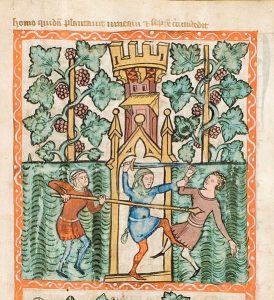The Parable of the Wicked Tenants
Mount Calvary Church
A Roman Catholic Parish
The Personal Ordinariate of S. Peter
Eutaw Street and Madison Avenue
Baltimore, Maryland
Rev. Albert Scharbach, Pastor
Andrew Johnson, Organist and Music Director
Trinity XVII
October 4, 2020
8:00 A.M. Said Mass
10:00 A.M. Sung Mass
This mass will be livesteamed.
________________________
Organ Prelude
“Partita on Aurelia,” Andrew Johnson
Andrew Johnson composed this suite in 2018. Each movement was written to capture the text of “The Church’s One Foundation,” the most recognisable setting of S.S. Wesley’s tune, Aurelia. The first movement introduces the tune in a chorale texture that is reharmonized to reflect the text of verse one, while the second movement is a solo melody with a lush accompaniment to embody the oneness of the second verse. The final movement, today’s postlude, is a joyful exclamation of one day uniting with Christ and the departed in heaven.
Organ Postlude
“Toccata on Aurelia” A. Johnson
_____________
Offertory
Thou Wilt Keep Him in Perfect Peace, Samuel Sebastian Wesley (1810-1876)
Thou wilt keep him in perfect peace,
whose mind is stayed on thee.
The darkness is no darkness with thee,
but the night is as clear as the day.
The darkness and the light to thee are both alike.
God is light and with him is no darkness at all.
Oh let my soul live, and it shall praise thee,
for thine is the kingdom, the power,
and the glory, for evermore.
Samuel Wesley is the same English organist who wrote today’s closing hymn tune, AURELIA. He came from a rich heritage of musicians and clergy in the Methodist tradition including his grandfather, Charles Wesley. Samuel Sebastian creates a unique musical atmosphere for each textual section, ending with a return of the calming opening refrain.
________
Communion
O sacrum convivium à 6, Tomás Luis de Victoria (1548-1611)
“O sacrum convivium,
In quo Christus sumitur,
Recolitur memoria passionis eius;
Mens impletur gratia,
Et futurae gloriae, nobis pignus datur.
Alleluia.
O sacred banquet,
in which Christ is received,
the memory of His Passion is renewed,
the mind is filled with grace,
and a pledge of future glory is given us.
Alleluia.
Tomás Luis de Victoria was the premiere Spanish composer of Renaissance polyphony in the 16th century. His music mirrors the ideals of smoothness and intelligibility found in Palestrina, but also explores more expressive techniques and text painting. This piece epitomizes the technique of imitation and features frequent voice crossings throughout.
_______________
Hymns
O for a heart to praise my God (AZMON) is by Charles Wesley (1707-1788). This hymn has the Wesleyan emphasis on the religion of the heart, which is transformed by the saving blood of Jesus. The hope for perfection is deeply Wesleyan. The Beatitudes likewise point the Christian to greater and greater perfection: Blessed are the pure of heart, blessed are the meek. Perfection is found in love, because we become sharers of the divine nature, and Jesus reveals the “new, best name” of God, Love. The tune AZMON is an adaptation by Lowell Mason (1792-1872) of a tune by Carl Gotthelf Gläser (1784-1829).
Rock of ages (TOPLADY) has been a stay and comfort in days of peril, and in the hour of death. No other English hymn has had so broad and firm a grasp upon the English-speaking world. It was written by the Rev. Augustus Toplady (1740–1778), a priest of the Church of England. Although Toplady was a Calvinist, the words, “Be of sin the double cure” suggest that he agreed with John Wesley, who taught the “double cure,” in which a sinner is saved by the atonement of Jesus, and cleansed from inbred sin by the infilling of the Holy Spirit. Traditionally, it is held that Toplady drew his inspiration from the gorge of Burrington Combe in the Mendip Hills in England. Toplady, was travelling along the gorge when he was caught in a storm. Finding shelter in a gap in the gorge, he was struck by the title and wrote down the initial lyrics.
The tune TOPLADY is by the American Thomas Hastings (1784-1872). As a teenager, Hastings led a village choir, taught singing, and was active in the musical society of Oneida County. By 1832 he had moved to New York City where he conducted the Bleeker Street Church and by 1858 the University of New York awarded him an honorary Doctorate in Music. He composed over 600 tunes used for hymns.
The Church’s one foundation (AURELIA) was written by Samuel John Stone (1839—1900) as an expansion of the article in the Creed: “The Holy Catholic Church, the Communion of saints.” Bishop Colenso of South Africa had denounced most of the Bible as fictitious; in response Stone wrote this affirmation of the Church, which, although afflicted by heresies and schisms, still reflects the unity of the Trinity and the glory of the Church Triumphant in heaven. The tune AURELIA is by Samuel Sebastian Wesley (1810—1876), the son of the composer Samuel Wesley, and grandson of Methodist hymnwriter Charles Wesley.

